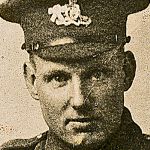Gunner 116211, 301st Siege Battery, Royal Garrison Artillery
Died 12th September 1918, aged 33
Remembered at Croix-Rouge Military Cemetery, Quaëdypre
& on both Blakeney War Memorials
George was born in Blakeney and baptised there, 3rd May 1885, the son of George and Grace Hudson nee Howlett of St. Margarets, High Street, Blakeney. He was the brother of Grace, Gladys and John, who served in the Indian Army. George married Ellen Walker of Blakeney and was the father of Alan George and May, born 1909 and 1912 respectively.
George enlisted at Enfield, 1st December 1915, aged 30 years and 9 months and stated that earlier he had been with the Norfolk Imperial Yeomanry. He was initially placed with the Royal Garrison Artillery (RGA) reserves until moved the following year to the 18th Company RGA when he saw action with the Eastern Coast Defences. During this time he underwent specialist shore and signalling training at Chatham and was then stationed with the 1st Reinforcing Depot at Bexhill before being posted to the 321st Siege Battery (SB) and embarking for France in May 1917.
Three months later he was admitted to hospital for two weeks with “PUO” (Pyrexia of unknown orign), meaning fever. Within a week of returning to duty on the front line, the fever was back and he was readmitted to hospital on 30th July, the very eve of the Third Battle of Ypres that led to the fall of Passchendaele. He was passed along the medical line till invalided back to England from No. 30 Base Hospital in Calais.
After time spent recovering in the UK, probably at Gosport (the Heavy and Siege Battery Depot) he was moved first to Shoreham then posted back to France for the second time where he joined the 301st Siege Battery of the 4th Brigade on 24th March 1918. The 301st Siege Battery had just suffered heavy losses in the German Spring Offensives at Lys and George was just one of many men sent in to bring the battery back up to strength.
Later that year, between mid August and early September, his battery began advancing from their base camp at Walker Farm that was located between Ypres and Dicklebusch. They pushed forward across the Fields of Flanders and had their heavy guns in position ready to take Wytschaete and Messines Ridge when on 7th September, they were badly shelled at their base, suffering 6 casualties, 3 wounded and 5 gassed. That very same week, although not necessarily from that particular action, George was admitted to the 10th Casualty Clearing Station at Arneke, France suffering with gunshot wounds to his left shoulder, right arm and leg. This was a front-line hospital, situated about 50 km SE of Calais and almost due west of Ypres, and was where George would have met a surgeon for the first time. His right leg and left foot were amputated that same day and sadly, George failed to pull through.
He is buried at Croix-Rouge Military Cemetery, just inland from Dunkirk. This is a very small cemetery with just 89 burials from both World Wars although the majority are WW1 soldiers who died between July and September 1918. His records show that it took a further 3½ years before his widow Ellen, now living at Manor Farm, Glandford, received firstly her pension, followed by his possessions, death plaque and finally his medals. The latter were delivered to her solicitors, Butcher and Andrews, Holt in March 1922.

